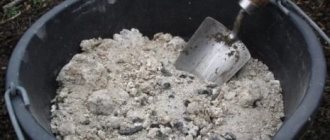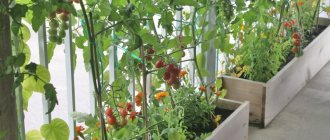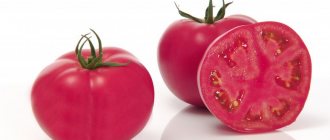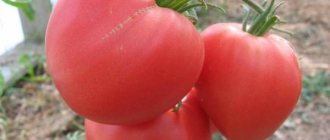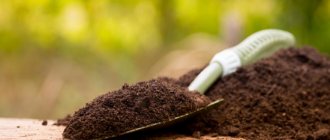Description of the tomato variety Black Elephant
The variety is indeterminate and can grow throughout the season. More often the bush is semi-spreading, reaching a height of 1.4-1.5 m.
The leaf blades are large, dark green in color, and resemble potato leaves in appearance. The first inflorescences form above 8-9 leaves, and then every 3 leaves.
Tall shoots need to be formed and tied up, since under the weight of the fruit they can break or bend to the ground. It is recommended to regularly plant the Black Elephant tomato and plant it in 2 stems.
Fruit formation begins 105-115 days after sowing raw materials for seedlings
Description of fruits
The fruit shape of the Black Elephant variety is flat-round with strong ribbing. The skin is dense, green at first, but as it ripens it turns red and then red-brown. The dark shade predominates at the stalk.
The pulp inside is juicy, fleshy, red in color. In the seed chambers the shade is brownish-brown with greenery. The taste of the vegetable is sweet, there is practically no sourness. From the photo of the Black Elephant tomato, you can evaluate the attractiveness of the harvested crop, but the fruit is also characterized by a pleasant, pronounced aroma.
Important! The presence of dark “shoulders” on Black Elephant tomatoes is explained by the content of anthocins in the fruit. The large amount of lycopenes and carotenoids in the vegetable helps strengthen the human immune system.
The weight of each fruit varies from 100 to 400 g
Basic information about the variety
Tomato bushes, depending on growing conditions, can reach 150-160cm. The leaves are potato-type, rich green in color. Requires the formation of 2-3 stems, pinching and tying to the trellis.
- The shape is flat-round.
- The weight of tomatoes varies, according to reviews, from 100 to 400g. bulk about 200g.
- The color of tomatoes is red-brown when ripe.
- The pulp is very juicy and fleshy.
- The high sugar content of the pulp makes its taste original and unusually attractive.
- It is used mainly fresh, as well as in other dishes and salads, as well as for preservation in ketchup and tomato paste.
Characteristics of the Black Elephant tomato
You can grow tomatoes in any region of Russia, but in most of them it will be necessary to install a greenhouse. Without shelter, the Black Elephant tomato is cultivated in the Rostov region, Krasnodar region, the North Caucasus and other areas with a warm climate.
Black elephant tomato yield and what affects it
The variety is usually classified as high-yielding. In unprotected soil, up to 12-15 kg of fruit can be collected from 1 m2. The average yield from 1 bush from an open bed is 4-5 kg.
In greenhouse conditions it is possible to collect up to 15-20 kg per 1 m2. From 1 bush the yield is 5-7 kg.
To get the maximum possible values for fruiting, it is not enough to transfer the tomato to a greenhouse. The yield of the Black Elephant tomato is negatively affected by refusal of formation and pinching, lack of fertilizing and support.
The more main stems the gardener leaves, the smaller the fruits will be.
Resistance to diseases and pests
Tomato does not have strong immunity. The plant does not tolerate excess moisture well, so it is susceptible to late blight and rot. This feature is associated with both the long ripening period and excessive watering of the Black Elephant variety without subsequent ventilation of the greenhouse.
Fusarium on tomatoes is often recognized at the height of the disease, mistakenly assuming a lack of fertilizing. Starting from the lower leaf blades, one can notice yellowing of the foliage, gradual wilting and curling, and a white coating on the roots. If you cut the stem, the “vessels” will be brown.
Often the height of the disease occurs during flowering or ovary formation.
Rot is characterized by the appearance of white or brownish spots on the plant and a change in the color of the fruit.
Black elephant tomatoes affected by rot become deformed, turn brown, and fall off the branch.
Among the pests there is a risk of attack by the Colorado potato beetle, aphids, slugs and whiteflies.
Area of application of fruits
The main purpose of the variety is salads. In addition to adding to various dishes, medium-sized fruits are suitable for whole-fruit canning. Tomatoes make delicious juices and ketchups. And although tomatoes are transportable, they do not have a high shelf life, it is only 1-2 weeks.
Agricultural technology
When starting to grow Dragon Eye, you need to familiarize yourself with the description of the variety, requirements for choosing a location and planting pattern. Care is also important, which includes a lot of manipulations.
Choosing a place and landing
Currant bushes grow well in an open sunny area, with light partial shade possible.
The soil should not have time to freeze before planting and should not be too wet
When purchasing two-year-old seedlings, you should pay attention to the condition of the root system. The roots must have a healthy color, the presence of rotten and damaged roots is excluded
The presence of several buds on the “root neck” is mandatory.
Planting pattern:
- Clear the soil of all perennial weeds.
- Dig a hole 50x50 cm in 2–3 weeks. before landing.
- Lay drainage made of broken tiles or bricks at the bottom.
- Fertilize the soil with organic matter (rotted manure, peat) up to 10 kg per 1 m², you can add a little clay to increase the permeability of moisture and air.
- Add 2 tbsp phosphorus fertilizer to the hole. l. double granular superphosphate.
- Pour 5–7 liters of water into the planting hole.
- Immediately before planting, soak the plant in water for a couple of hours.
- Place the seedling in the prepared hole with a slope of 45°. Cover with soil, compacting.
- Deepen the root collar by 5 cm. 1–2 buds should remain on the surface.
- Water generously with warm water at the rate of 10 liters per bush.
- Trim all shoots to 2.5 cm to further stimulate the development of new shoots.
- Apply mulching material around the tree trunk circle. Straw, mown grass, and sawdust are suitable. When using peat-manure compost, add up to 4–5 kg of it per bush.
Watering is best done in the evening. In the first 2–3 weeks after planting, the plant is watered with about 2 buckets under the bush. In spring and summer, if there is no rain, up to 3 buckets of water are poured under each bush.
The following options are possible:
- The mullein solution is diluted with water 3 times. The resulting solution is applied at the rate of: 10 liters of fertilizer per 1 m².
- The bird droppings solution is diluted 10 times with water. The resulting solution is applied at the rate of: 5 liters of fertilizer per 1 m².
Immediately after fruiting, the plant must be given potassium-phosphorus fertilizer: dissolve 20 g of fertilizer in 10 liters of water. Fertilizing is carried out along the perimeter of the crown of the bushes. It is necessary to loosen the soil and remove weeds. Hoeing at the base of the bushes should be avoided, as the hoe can cut through new shoots developing at the base.
Advantages and disadvantages
The variety attracts the attention of gardeners with its unusual decorative appearance. But tomatoes are also valued for their taste and high content of nutrients.
The advantage of the variety is its abundant, long-term fruiting, which allows you to enjoy the fruits throughout the season.
Advantages of tomatoes:
- the plant grows successfully both in open ground and under cover;
- the fruits contain a high content of substances beneficial to the body;
- exotic look.
Disadvantages of culture:
- low immunity to late blight;
- the need for shaping, gartering;
- poor keeping quality.
Important! Among other salad varieties, the Black Elephant tomato is the most productive, although it requires physical effort during cultivation.
History of creation
Black elephant is a relatively young variety. It was bred in the 1990s and applied for registration in 1998. In 2000, the crop was included in the Register and allowed for cultivation in the Russian Federation.
Related article:
How to get a rich harvest of tomatoes in open ground using little tricks
To get a new variety of tomatoes, scientists had to cross wild and cultivated varieties. As a result, it was possible to develop a tomato with a black tint and amazing taste.
Features of planting and care
Planting begins with sowing seedlings. All raw materials are treated with a solution of manganese and a growth stimulator, the containers are washed, and ventilation holes are made.
The soil is prepared in advance by mixing soil from the garden with ash and compost. To make the soil mixture looser, it is recommended to add sand or peat. As a replacement, you can use soil from the store.
Sowing is carried out at the beginning of March if it is planned to cultivate the variety in a greenhouse, and at the end of March if the Black Elephant tomato will be grown in open ground.
Sowing:
- pour earth into the box;
- moisten the soil and make rows with a distance of 1.5-2 cm;
- sow the raw materials, cover the top of the container with film.
Important! The optimal temperature for emergence of seedlings is + 15-16 °C during the day and + 12-13 °C at night.
Care during this period consists of ventilating the seedlings, watering them, and providing sufficient lighting.
As soon as shoots appear, the cover from the container must be removed
The appearance of 2-3 true leaves is a signal for picking seedlings into separate containers. Further care consists of watering and fertilizing. 2 weeks before transplanting seedlings to a permanent place of residence, they should be taken outside for hardening.
Up to 3 bushes are allowed per 1 m2. The distance between each plant should be at least 50 cm.
It is recommended to add lime or organic fertilizers to the dug holes. It is better to transplant seedlings at the age of 50-60 days in the evening. To do this, remove the bush from the pot along with a lump of earth, place it in a hole, cover it with earth and water it abundantly.
It is recommended to cover the Black Elephant tomatoes with material immediately after planting to help the plants adapt
Tomato care includes the following steps:
- watering as needed;
- loosening followed by mulching;
- organization of support or garter.
Throughout the entire season, the stepsons of the Black Elephant tomato need to be removed, and the tomato itself should be formed into 2 stems. You need to tie up a seedling 80-100 cm high.
It is recommended to build a trellis as a support or use metal stakes
There are no special features in applying fertilizers: the first fertilizers should be added to the soil 2-3 weeks after planting, then provided with useful substances every 5-7 days. If the Black Elephant tomato is grown in a greenhouse, then it is enough to feed it once every 10 days. Complex mineral and organic mixtures can be used as fertilizers.
How to grow seedlings
Another feature of the “Pink Elephant” is that it is grown only by seedlings, regardless of climatic conditions.
Seed preparation
Step-by-step steps for preparing seeds for planting are as follows:
- At the beginning of March, it is necessary to begin preparing seeds for seedlings in order to sow them in the second half of the month. In warm regions, seeds begin to be prepared earlier, and so are planted accordingly. To begin, treat the material purchased or prepared from the last harvest in a solution of potassium permanganate for about 30 minutes. We throw away the floating seeds; they will not sprout.
- After treating with potassium permanganate, rinse them under running water.
- Dry the resulting seeds.
- For a successful harvest, fertilizing should begin from the seeds. Before sowing, we treat the seeds with growth stimulants, for example, “Immunocytophyte”, “Agat-25K”, or a natural stimulant - aloe.
- Seed germination consists in turn of the following stages:
- Pour water into a shallow plate, place gauze or other cotton material;
- put the seeds;
- cover with the same material;
- watch when the seeds break through.
Container and soil
To plant sprouted seeds, it is recommended to prepare:
- thin plastic containers with lids;
- deep containers with a tray and drainage.
Use purchased soil recommended for sowing peppers and tomatoes, or you can mix the soil in which the seedlings will be planted with ash, humus and sand (ratio 2:1:1:1).
Sowing
After preparing the planting material, containers and soil, we begin to sow the seeds.
To do this you should:
irrigate the soil with water; make shallow paths; plant seeds no deeper than 2 cm; carefully irrigate the soil; cover the plantings with cellophane or a transparent container lid; place them where it is light and warm - approximately 25 C°; after the seeds have sprouted, the covers or film should be removed and the plantings should be moved to a cool place with a temperature of about 21 C°.
Growing and care
To obtain high-quality seedlings, proper care is required:
- regular watering - monitor the condition of the soil, avoid drought or overwatering;
- good illumination - up to 10-12 hours a day, if there is not enough natural light, use lamps or lamps;
- after the first pair of leaves appears, picking is carried out;
- At the picking stage, carry out the first feeding of the soil with the mineral complex “Nitroammofoska”.
Tomato Pink Elephant. vendor code
Watch this video on YouTube
Pest and disease control methods
Even before transferring the seedlings to open ground, it is recommended to treat the plants prophylactically with any fungicide: Topaz, Profit, Fundazol.
For insects, you can use insecticides such as Aktara, Karate, Fufanon.
Treatment of bushes should be carried out according to the instructions, on the leeward side, using personal protective equipment, irrigating the bushes with a spray bottle
Important! If pests attacked during the ripening period of Black Elephant tomatoes, then the use of chemicals is not recommended. Insects should be destroyed mechanically.
If signs of disease are detected, it is necessary to remove all damaged parts of the plant and treat the bushes with the drug. Loosen the soil around them and ventilate the room if the crop grows in a greenhouse.
